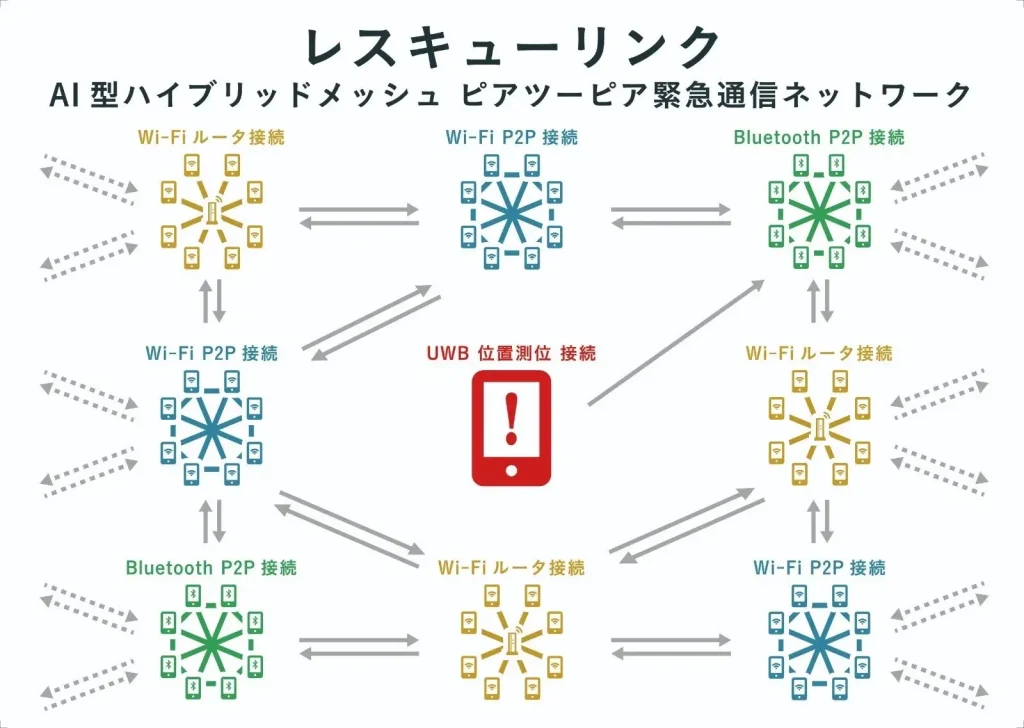Cognitive Research Lab, Inc. (hereafter CRL; Headquarters: Minato-ku, Tokyo; CEO: Hideto Tomabechi) has started providing the AI-based mesh emergency communication feature “Rescue Link” for free within the iOS app “Cognitive Fort Talk.”
This feature utilizes Wi-Fi and Bluetooth for device-to-device communication, as well as Wi-Fi routers and UWB (Ultra Wideband), allowing AI to automatically construct a mesh network. This ensures that even if mobile phone networks or the internet become unavailable due to large-scale disasters, people can still communicate with each other, including between rescue teams and victims. Moreover, even in areas with no signal, such as wilderness or mountainous regions, app users can communicate with each other like using a walkie-talkie.
CRL is committed to providing cutting-edge technology through the free app “Cognitive Fort Talk” to ensure the safety and security of as many people as possible.
“Cognitive Fort Talk” is a next-generation SNS app designed with a focus on privacy and security. By employing the latest encryption technology, advanced multilingual translation functions, and cutting-edge AI technology, it offers users a safe and comfortable communication experience. Additionally, it promotes activities that contribute to society, direct democracy, supports high-quality journalism based on real-name systems, and introduces a unique economic model called “half-life currency,” aiming to build a better society.
One of the standout features of “Cognitive Fort Talk” is the “Rescue Link” function. This system was developed to protect the lives of citizens and avoid national crises caused by disasters, emergencies, cyber terrorism, and large-scale power outages that disrupt communication networks. Unlike traditional centralized communication networks, it adopts a decentralized network structure using Wi-Fi routers (supporting local communication even when disconnected from the internet), Bluetooth, P2P-Wi-Fi between devices (a technology where devices communicate directly via Wi-Fi), and UWB (Ultra Wideband), with AI automatically constructing a mesh network. This enables communication between individual devices even when central networks are non-functional.
All devices in this system can connect to multiple devices simultaneously, providing resilience in dynamically changing situations through multipoint connections, multiple routes, and redundancy. Additionally, real-time high-precision location measurement using UWB technology constantly updates the relative distance and direction between users. UWB is a low-power, high-bandwidth wireless communication technology enabling precise location measurement. Especially during emergencies in urban areas, it provides quick and accurate location information to support rapid rescue activities and the swift transportation of the injured.
Furthermore, with advanced encrypted connections, it ensures complete P2P encrypted communication without passing through Wi-Fi routers in situations requiring confidentiality, such as emergencies or counter-terrorism. P2P communication refers to direct communication between devices without a central server. This decentralized communication method does not require centralized
management and allows individual devices to operate autonomously, sharing the fundamental concept of blockchain technology, known for enabling decentralized data management.
By providing this system for free, we offer an innovative solution to ensure the safety of citizens during emergencies and overcome national crises. We believe that this advanced technology will significantly contribute to life-saving and enhancing societal resilience. This system not only serves as a communication means during crises but also expands the potential for everyday communication. For instance, it can be used in remote areas with weak communication infrastructure or to ease congestion at large-scale events, thus aiming to create a safer and more connected society.

This system holds the potential to bring innovation to both emergency communications during disasters and everyday life communications. For example, the high-precision location sharing enabled by UWB technology can greatly assist in everyday navigation and meeting arrangements. The technological foundation of this system enables such a wide range of applications.
Advanced Technologies Supporting Rescue Link
By combining multiple advanced technologies, it enables swift and effective communication during disasters and emergencies. These technologies also have the potential to improve communication convenience in normal times. Here are the main technologies supporting this system:
1.AI-Based Automatic Network Construction: It automatically builds a mesh network without relying on radio towers or internet infrastructure. AI technology allows each device to autonomously select the optimal connection, constructing a network with minimal human intervention. Furthermore, by integrating UWB technology, it achieves network construction using high-precision location information.
2.Real-Time High-Precision Location Measurement with UWB: Utilizing cutting-edge UWB technology, it enables real-time high-precision location measurement. UWB technology updates the relative distance and direction between users in real-time. During disasters in urban areas, this function provides quick and accurate location information to support rapid activities at disaster sites. UWB technology achieves higher accuracy in indoor location measurement compared to GPS. It also enables more efficient network operation by integrating with AI-based automatic network construction.
3.Combined Use of Wi-Fi and Bluetooth: It supports wide-area communication by skillfully combining Wi-Fi and Bluetooth. Wi-Fi operates using radio waves only and does not require internet connection, making it functional even when communication infrastructure is damaged. Bluetooth operates with low power, making it suitable for continuous use. Several proprietary technologies are integrated to optimally combine these technologies, significantly contributing to the construction and maintenance of a mesh network.
4.Dynamic Mesh Communication Technology: It expands the communication range through nearby devices even if communication infrastructure is damaged. This system optimizes and delivers messages and chats, constructing an automatic and rapid emergency information transmission network. It is effective even in environments with poor radio wave reception, such as underground shopping areas and high-rise buildings.
5.Sharing Location Information Without Relying on GPS: It shares users’ location information even when GPS is non-functional. It supports rescue activities and navigation to evacuation centers, enabling efficient rescue operations. By integrating with UWB technology, it allows sharing of more precise location information.
6.Multipoint Connection Function: This system supports multipoint connections, allowing simultaneous connection to multiple devices. This function enables rapid and wide-area communication during disasters. For example, rescue workers can communicate simultaneously with victims and other team members using multiple devices, greatly improving rescue efficiency. The multipoint connection function provides a stronger communication foundation when integrated with dynamic mesh communication technology and AI-based automatic network construction. The seamless integration of these advanced technologies results in exceptional performance. AI-based automatic network construction and UWB technology integration, the combined use of Wi-Fi and Bluetooth, dynamic mesh communication technology, and the combination of location information sharing without relying on GPS and multipoint connection functions all complement each other to ensure reliable information transmission during disasters and emergencies.
These advanced technologies hold the potential to significantly transform disaster response and offer higher levels of protection for the lives and safety of people worldwide. This groundbreaking tool will play a crucial role in safeguarding the lives and safety of citizens during emergencies. CRL will continue to improve these advanced technologies to realize more effective emergency communication. We will continue to innovate and provide cutting-edge solutions to protect the lives and safety of people worldwide.
The advanced technologies of this system provide a strong foundation for protecting people’s lives during disasters and emergencies.
Here are specific roles it plays during disasters:
1.Emergency Communication as a Lifeline Immediately After a Disaster: Emergency communication immediately after a disaster serves as a lifeline for victims. It functions as an emergency contact network when communication infrastructure is disrupted. Victims can contact family and friends, confirm their safety, and request rescue through this system. Ensuring such emergency communication reduces victims’ anxiety and is essential for swift rescue operations.
2.Supporting Efficient Rescue Operations: It supports efficient rescue operations by allowing rescue teams and volunteers to share information at disaster sites. By sharing real-time information about the situation and the location of victims, limited resources can be maximized, making rescue operations more strategic. This enables the saving of more lives.
3.Essential for Information Exchange and Coordination at Evacuation Centers: At evacuation centers and temporary relief bases, this system serves as a vital tool for information exchange and coordination. It promotes communication between victims and support organizations, ensuring smooth distribution of necessary support and resources. By sharing problems and requests within evacuation centers, it can more accurately address victims’ needs, making it indispensable for evacuation center management.
4.Realizing Effective Network Operation with AI Optimizing Communication Paths: Based on signal strength, connection speed, power consumption, and other environmental factors, AI dynamically meshes communication paths.
This ensures the most optimal communication path is always secured, maintaining stability and efficiency. Using AI minimizes human resources while maximizing effective network operation, playing a vital role in utilizing limited resources during disasters.
5.Enhancing Data Sharing: Combining Wi-Fi and Bluetooth supports sharing large data and media files. This strengthens information sharing and communication during disasters, allowing a more detailed understanding of the situation. For example, sharing photos and videos from disaster sites enables remote support organizations and decision-makers to understand the situation accurately and take appropriate support measures. The data- sharing function of this system significantly contributes to disaster site support.
6.Providing Communication and Location Information to Protect Lives When Communication Infrastructure is Severed: This system provides communication even if mobile phone networks or the internet are severed. It also provides location information using UWB technology even when GPS is destroyed, enabling more effective confirmation of victims’ safety and rescue operations. This role is crucial for protecting lives in situations where communication infrastructure is entirely non-functional.
7.Optimal Combination of Communication Technologies to Respond to Any Situation: This system optimally combines various communication technologies to create an environment available for use. This includes Wi-Fi routers during internet disconnection, Bluetooth, and peer-to-peer direct mesh connection between iPhones. This combination ensures flexibility and adaptability to respond to any situation during disasters. Choosing the optimal communication means according to the situation also conserves power, enabling long-term operation. This combination of communication technologies forms the foundation of communication during disasters.
8.Providing High-Precision Location Information Using UWB Technology: Using UWB technology provides high-precision location information. Utilizing this information enables the accurate identification of victims’ positions, making rescue operations more efficient.
These scenarios highlight the critical role our system plays during disasters and emergencies. CRL aims to leverage this technology to save more lives and alleviate the suffering of those affected by disasters. This innovative technology has the potential to significantly improve the efficiency and effectiveness of disaster response by connecting victims with rescue teams, facilitating information sharing, and enhancing coordination.
- Wi-Fi Routers: Typically cover a range of 50 meters indoors, extending to several hundred meters outdoors.Bluetooth: Generally effective within a range of about 10 meters.Peer-to-Peer Direct Mesh Connections between iPhones: Effective up to 30 to 50 meters.
- Leveraging UWB Technology
To utilize UWB technology, devices must be equipped with an iPhone 11 or later, featuring the U1 chip. Devices running iOS 16.0 or later can leverage UWB to estimate distance, direction, horizontal angle, and vertical direction. Devices running iOS versions below 16 can only estimate distance and direction.
As these case studies demonstrate, the system plays a crucial role in crisis situations and emergencies. To maximize its effectiveness, regular familiarity with these features in daily life is essential. Here, we outline key points for utilizing the system in disaster preparedness.
Daily Usage of RescueLink
- Maintain Battery Charge and Prepare Backup Power
- During disasters, power supply can be unstable. Regularly charge your devices to ensure they have sufficient power. It’s also essential to have backup power solutions ready, such as rechargeable external batteries or hand-crank chargers, to maintain functionality in emergencies.
- Keep Wi-Fi and Bluetooth On
- For effective system use, always keep Wi-Fi and Bluetooth enabled. Wi-Fi signals have a long reach and can be used even if the internet connection is lost, provided power is maintained through portable power sources. Wi-Fi can greatly contribute to communication during disasters. Bluetooth operates with low power consumption and is recommended to be kept on continuously.
- Minimize Standby Power Consumption of the Cognitive FortTalk App
- The Cognitive FortTalk app, equipped with this system, is designed to remain active even when not in use, ensuring it’s ready for immediate use in emergencies. The app is optimized to minimize standby power consumption, allowing it to be reliably available without significantly draining the battery.
- Regular Use of the Cognitive FortTalk App
- Familiarity with the app during non-emergency times is crucial for smooth operation during crises. Regularly using the app and familiarizing yourself with its features will ensure quick and efficient use when needed. It’s also advisable to register as “friends” with contacts you may need to reach in emergencies, facilitating faster and more reliable communication.
By implementing these preparations, the system can be effectively utilized during emergencies. Next, we will discuss new features being developed by CRL to extend the system’s potential into everyday life.

The RescueLink system extends its potential far beyond its initial purpose of ensuring communication during disasters and emergencies. It has proven to be a versatile tool in various daily communication scenarios. For instance, it can be used as a reliable means of communication in remote mountainous areas where cell signals are weak or as a group communication tool at large event venues. CRL has actively conducted field tests in the Himalayas to explore these potentials. Based on the insights gained from these tests, we are currently developing new features.
Below are the future prospects of RescueLink
1.Field Test in the Himalayas
The Himalayas, with its challenging environment and lack of cell signal coverage, provided an ideal setting for testing the capabilities of RescueLink. The field test demonstrated that the system could maintain communication between users even in such harsh conditions. This success marks a significant milestone towards future advancements.
2.Bluetooth Range for Individual and Group Chats
As long as one user is within Bluetooth range, it is possible to conduct individual or group chats via a mesh network. This feature is particularly effective as a means of communication in areas with no cell coverage. Hikers can keep track of each other’s positions, and groups can share information at evacuation shelters, among other scenarios.
3.High-Range Mesh Communication with Internet Connectivity
If at least one user can access the internet, high-range mesh communication becomes feasible. This allows for extended communication ranges and significantly broadens the scope of information sharing. For example, in a mountain rescue operation, if part of the rescue team is in an area with internet access, they can relay real-time updates to the headquarters, enabling precise instructions and swift support.
4.Development of Dynamic Mesh Transceiver Functions
Following the successful field tests in the Himalayas, CRL is developing dynamic mesh transceiver functions to further enhance communication range and efficiency. This new feature will make the system more versatile across various scenarios.
Examples:
- In the event of a large-scale earthquake where buildings collapse, causing rescue teams to split into multiple groups, the dynamic mesh transceiver function can maintain communication between groups, facilitating coordinated rescue operations.
- During mountain search and rescue missions, where teams often need to disperse widely, this function will enable smooth information sharing among team members, significantly improving search efficiency.
Moreover, the dynamic mesh transceiver function is not limited to disaster scenarios. It can also be used in daily outdoor events.
Examples:
- At large music festivals or sports events where many participants are spread across a wide area, organizers and staff can use this system to maintain contact, ensuring smooth event management.
The dynamic mesh transceiver function is a crucial technology that expands the utility of the RescueLink system in various scenarios, including disaster rescue operations and everyday outdoor events. CRL aims to evolve this system into a tool that benefits more people through ongoing development of this new feature.
The RescueLink system transcends its original purpose as an emergency communication support tool, promoting communication in diverse environments and situations. CRL is committed to maximizing the potential of this system and contributing to society.
The RescueLink system has the potential to revolutionize disaster rescue operations. It can significantly enhance the efficiency and effectiveness of disaster response, such as identifying the location of survivors in collapsed buildings during an earthquake and coordinating with rescue teams for swift rescues. In daily life, it can also foster human connections. For example, families living in remote mountainous villages can stay in touch, or groups can form and interact at large events. This system offers a new means to deepen interpersonal connections.
In conclusion, by leveraging advanced technologies and continuous development, CRL aims to make the RescueLink system an indispensable tool for both disaster response and everyday communication, ultimately enhancing safety, connectivity, and efficiency in various aspects of life.

CRL is dedicated to exploring the future potential of RescueLink, striving to deliver peace of mind, safety, and enhanced communication to more people. We are committed to meeting your expectations by fully dedicating ourselves to the research and development of innovative technologies. CRL will continue to challenge itself in realizing a disaster-resilient society with stronger bonds, driven by the advancements made through this system.

App Store (Cognitive Fortalk): https://crl.fi/forttalk
Official website: https://www.crl.co.jp/
